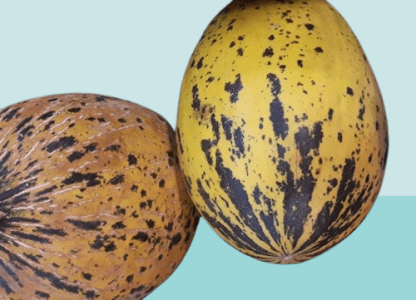In the UK, melons that are well-suited for the cooler climate and shorter growing season are generally preferred. The most common and widely grown melon varieties in the UK include:
- Cantaloupe (Muskmelon): Cantaloupe melons are a popular choice in the UK. They have sweet, orange flesh and a distinctive aroma. Some cold-tolerant varieties are available that can be successfully grown in the UK’s climate.
- Honeydew Melon: Honeydew melons have pale green flesh and a subtle, sweet flavor. They are also a good choice for growing in the UK.
- Galiamelon (Galia): Galiamelons have a unique taste with a mix of cantaloupe and honeydew flavors. They are generally well-suited for cooler climates and are often grown in the UK.
- Charentais (French Cantaloupe): Charentais melons are a smaller variety with a sweet, flavorful, and aromatic orange flesh. They are known for their excellent taste and are also cultivated in the UK.
- Outdoor Watermelon Varieties: As mentioned earlier, some watermelon varieties are bred for cooler climates and have a shorter growing season. These varieties can be grown outdoors in the UK with proper care and protection.
The best melon variety for you may depend on your personal preferences, growing conditions, and the available space for cultivation. Many of these melon varieties can be grown in greenhouses or polytunnels to extend the growing season and protect the plants from cooler temperatures. Additionally, starting melon seeds indoors and transplanting seedlings outdoors when the weather warms up can help ensure a successful harvest.

Keep in mind that the availability of melon varieties in the UK can vary based on local nurseries, garden centers, and online seed suppliers. Therefore, it’s a good idea to explore the options available in your area and choose melon varieties that are known to perform well in cooler climates.
Where do melons grow best in the UK?
Melons grow best in the UK when they are cultivated in controlled environments such as greenhouses or polytunnels. The UK’s climate is generally cooler and less predictable, which makes it challenging to grow melons successfully outdoors, especially in regions with shorter growing seasons and lower average temperatures.
Greenhouses and polytunnels provide an advantage by creating a warmer and more stable microclimate for melon plants. They offer protection from cold temperatures, wind, and excessive rainfall, allowing melons to thrive and produce fruit even in the UK’s less favorable weather conditions.
When grown in greenhouses or polytunnels, melon plants benefit from the following advantages:
- Higher temperatures: The enclosed structure of a greenhouse or polytunnel traps heat from sunlight, creating a warmer environment during the day and retaining some of that warmth during the night.
- Extended growing season: With the controlled environment, the growing season for melons can be extended, starting earlier in the spring and continuing later into the autumn compared to outdoor cultivation.
- Protection from weather: Melons are sensitive to cold, wind, and heavy rainfall. Greenhouses and polytunnels shield the plants from adverse weather conditions, reducing the risk of damage or disease.
- Optimal humidity: Melons prefer relatively high humidity levels, which can be better maintained inside a greenhouse or polytunnel, particularly during dry spells.
- Controlled irrigation: Watering can be regulated more efficiently within a controlled environment, ensuring that melon plants receive consistent and appropriate moisture levels.
- Pest management: The enclosed space helps in reducing pest infestations, and it is easier to monitor and control pests when they are confined to a limited area.

If you want to grow melons in the UK and have the means to set up a greenhouse or polytunnel, this approach provides the best chances of success and a more reliable harvest. Additionally, choosing melon varieties that are specifically bred for cooler climates or have shorter growing seasons will further enhance your chances of growing healthy and delicious melons in the UK.
What season to plant melons in the UK?
In the UK, melons are best planted in late winter or early spring, typically starting from late February to early April. The specific timing can vary depending on your location within the UK and whether you plan to grow melons outdoors or in a greenhouse or polytunnel.
For outdoor cultivation, you should wait until after the last frost date for your region. The last frost date varies across the UK but generally falls between late April and early June, depending on the location. Planting melon seeds or transplanting seedlings outdoors before the last frost date risks exposing them to cold temperatures, which can stunt their growth or even kill them.
If you are growing melons in a greenhouse or polytunnel, you can start the seeds earlier indoors, about 6 to 8 weeks before the last expected frost date in your area. This allows the seeds to germinate and grow into seedlings in a controlled and warmer environment. Once the risk of frost has passed, you can transplant the seedlings into the greenhouse or polytunnel, where they will continue to grow and produce fruit.
Keep in mind that melons require warm temperatures to thrive, so it’s crucial to provide them with a suitable environment for germination and growth. Whether you’re growing outdoors or in a controlled environment, maintaining consistent temperatures and protecting the plants from cold weather and frost is essential for a successful melon harvest in the UK. Can it grow cavities in the UK? >>
